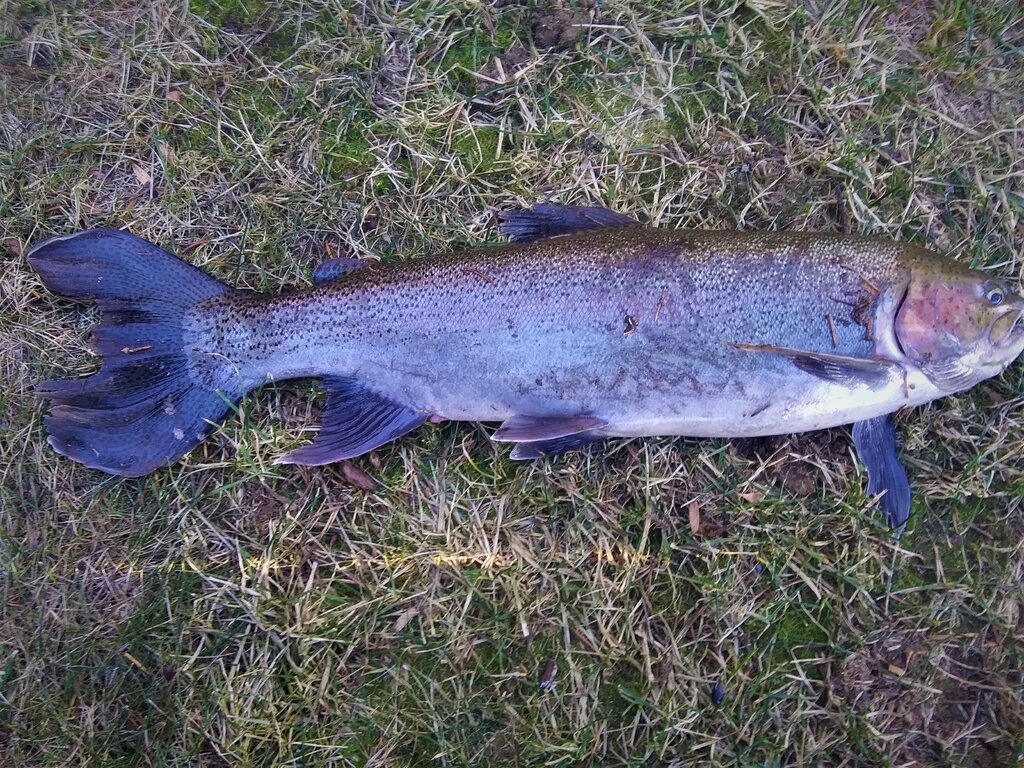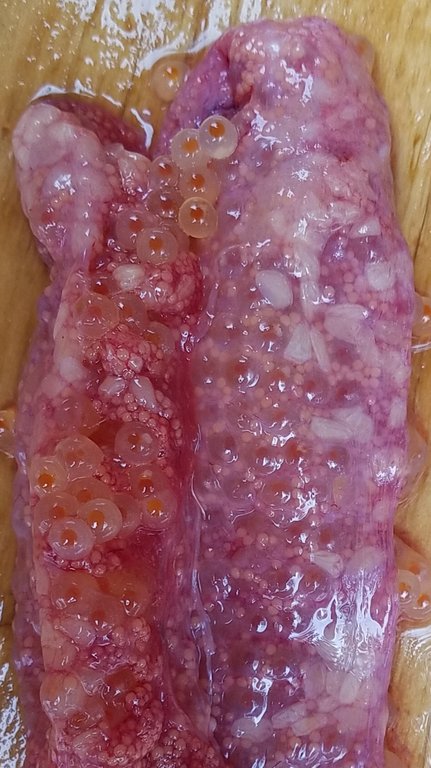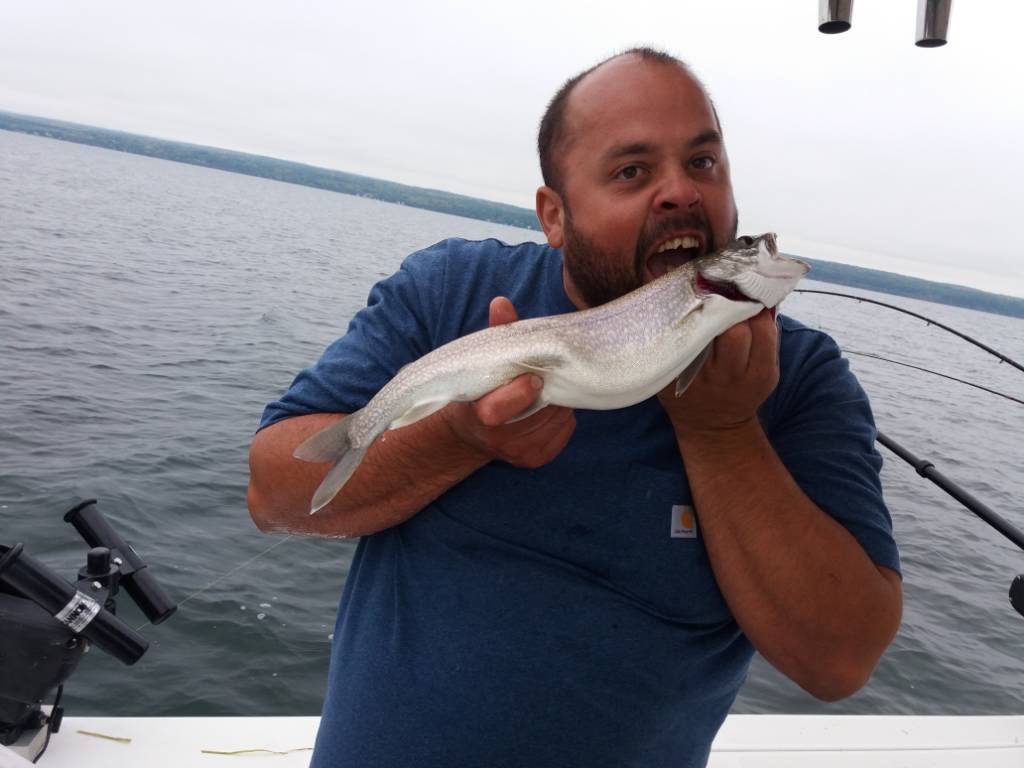

Lucky13
Members-
Posts
1,234 -
Joined
-
Last visited
Everything posted by Lucky13
-
They netted at the end of June. They likely netted at the bottom in relatively deep water, as the lake was likely starting to strongly stratify. Rainbows, browns and walleyes would be unlikely to be in that "slice" of the lake, they would still be shallower.
-

proposed cormorant control in Ontario.REMINDER 3RD JAN DEADLINE
Lucky13 replied to stlhdr1st's topic in Open Lake Discussion
It has always been my sense that New York would not mind getting rid of all the shags. It is the US Fish and Wildlife Service that controls those strings, not NYSDEC. -
Definitely a trophy there!! And in the summer, too! Back in the day, when there were a lot of bigguns around, I passed on mounting anything under 20, never broke that mark, and could have been admiring 5 bigger than 17, including a gorgeous 17 lb 5 oz hen, which I kept and weighed at Whitaker's at the request of the owner, Jim Rusher. As Whaler says, if it looks good to you, go for it. If you want to do C+R, take a lot of pix and go for a reproduction mount, they are really great these days, as you can sometimes see on ths website.
-

Another 20% CUT in Chinook Stocking for 2019
Lucky13 replied to Tall Tails's topic in Open Lake Discussion
This is not true. There is a dam on Beaver Dam brook not far upstream of the Rt 22 bridge over it, less than 1/4 mile upstream of the hatchery. If they were concerned about stopping natural reproduction in tributaries, they would have to deal with Trout Brook and Orwell Brook, both of which offer miles of good gravel. The gate on Beaver Dam forces the fish to take the ladder. After egg take they often drop the gate. -

What Lake Ontario fisheries topics do you want to hear about?
Lucky13 replied to schreckstoff's topic in Open Lake Discussion
How much except the license fee, and the Pittman Robertson money is actually available to use for "the maintenance of the fishery?" Seems to me that all the rest of that "revenue" ends up in private pockets. -
Three weeks ago there were fish cutting redds, fair numbers of hens around. Two weeks there were lots of solitary males around did not see a fish cutting in three days. Last week saw next to nothing except really zombie males, but the water went up after 1/2 day. I think the bulk of the salmon have come and gone, although a friend who works in the hatchery said there were still a few freshies in the ladder.
-
I caught a brown trout in Hemlock Lake a few years back that had the strangest color markings I had ever seen. I thought maybe it was a tiger trout, a brown brook hybrid. I sketched it as I did not have a camera. The DEC biologist with whom I spoke said they see all kinds of strange pigmentation. He also said that, just like with people, in any large population, some individuals will develop diseases. Maybe (and lets hope) that is what is showing here, not the beginnings of some new disease from somewhere else that came in on a boat, or in some of that “harmless” bait people think it is all right to haul from the Atlantic or down south. But I agree that it is important to document this stuff, and communicate it, as if it is problematic, the biologists have the heads up earlier rather than later.
-
DEC Stocks Lake Sturgeon into Upstate Waters State's Multi-Year Effort to Restore Threatened Species Showing Success New York State Department of Environmental Conservation (DEC) Commissioner Basil Seggos announced today that fisheries staff are busily stocking state-threatened lake sturgeon into several New York waters this month. The stocking effort is designed to help restore this threatened species. Commissioner Seggos said, "DEC's biologists and technicians are releasing sturgeon into waters these fish historically inhabited. Working with our local and federal partners, New York is bringing sturgeon back. I am proud of our hatchery employees and the work they do and happy to report that the project is successful." Approximately 4,000 lake sturgeon are being stocked this month. These fish were raised from eggs taken on the New York Power Authority property at the Moses-Saunders Power Project at Massena, NY, and raised at DEC's Oneida Hatchery in Constantia. The U.S. Fish and Wildlife Service and the U.S. Geological Survey were also involved in the egg take. Some of the eggs were taken to the Genoa National Fish Hatchery in Genoa, WI, where they were hatched, and the young sturgeon reared there are now returning to New York waters. Some of the fish to be stocked are being tagged for future identification. Passive Integrated Transponder tags ("PIT tags") are inserted under the skin into juvenile sturgeon. These are unique identifier tags like the ones placed in pets. They allow fishery biologists to identify individual fish over time as they are encountered in future sampling. October stocking efforts bring to fruition a cooperative, multi-year project. DEC has been actively working with federal, tribal, and university partners on protecting and restoring lake sturgeon throughout New York for more than 20 years. Beginning in 1993, DEC reared small numbers of eggs at the Oneida Hatchery. In 1995, nearly 18,000 fish were raised to six inches in size at the Oneida hatchery and released into Oneida, Cayuga, and Black lakes and the Grasse and upper Oswegatchie rivers. Hatchery fish were stocked in most years from 1995 to 2006, in these and other locations. Once abundant in the Great Lakes, Lake Champlain, and adjacent watersheds, lake sturgeon populations declined precipitously due to overharvest, declining water quality, and the placement of dams that restricted movement to spawning grounds. Efforts to clean up Great Lakes waters have been successful to date and sturgeon populations are now on the rise. Sturgeon harvest in the Great Lakes peaked in 1885. Lake sturgeon were prized for their eggs as caviar and the meat was smoked. The swim bladder organ of sturgeon was used to make isinglass, a gelatin used in brewing beer and wine. An ancient species that first appeared in the fossil record when dinosaurs roamed the Earth, lake sturgeon are native to the Mississippi River Basin, Great Lakes Basin, and Hudson Bay region of North America. Primitive in appearance, lake sturgeon have torpedo-shaped bodies covered with five rows of bony plates called "scutes." They are the largest fish native to the Great Lakes, growing to seven or more feet in length and weighing up to 300 pounds. A specimen that was 7 ft. 4 in. long, weighing 240 pounds, was found in Lake Erie in 1998. Lake sturgeon from New York's inland waters are smaller on average and may grow to as much three to five feet in length and 80 pounds as adults. These fish feed on the bottom and eat primarily aquatic insects, worms, snails, clams, and crayfish. Specimens caught in Oneida Lake have also been found to consume zebra mussels. Larger sturgeon have also been found to consume round gobies. One thousand sturgeon averaging about six inches long will be stocked into the following waters: Black Lake; Oswegatchie River; St. Regis River; Raquette River; Salmon River; and Genesee River. Approximately 500 lake sturgeon will be stocked in Oneida Lake and the St. Lawrence River at Massena. Two-thousand-five-hundred fish will be stocked into Chaumont Bay, Cayuga Lake, and the St. Lawrence River at Ogdensburg. While DEC and partners have discovered gravid or egg-bearing females and young fish in previously stocked locations, DEC will continue propagation of lake sturgeon through 2024. Low levels of stocking are continuing to enhance the genetic structure of previously stocked populations. Sturgeon are infrequent spawners and use the same gravel and cobble beds as do walleye. They congregate in tributary streams in late May to mid-June. Only about 10 percent of the population spawns in any given year. Males reach maturity at about age 15, and spawn only every second or third year. Females mature at about 20 years of age and spawn only every four to seven years. Bottom fishing with worms is likely to attract sturgeon, so that practice should be avoided in sturgeon waters. If an angler accidentally hooks a sturgeon, they should release it as quickly as possible and try not to remove it from the water. Always support its full weight across its abdomen; do NOT hang it by the gills or tail. Do not touch its gills or eyes. For more information on lake sturgeon, visit DEC's website. http://www.dec.ny.gov/press/77537.html
-

Another 20% CUT in Chinook Stocking for 2019
Lucky13 replied to Tall Tails's topic in Open Lake Discussion
Based on the SOL reports, no domestics go in the pens at Hamlin or Sandy, and the last time Washington Strain fish, which also run in the fall, were pen raised in Sandy (although the 2018 data is not available yet) was 2014. Sometimes when I attempt to do my research I only get partial information returned, so I am limited to the sources out there in print. But glad to hear you have a strong group, and don't need any additional help, and thanks for the efforts. And thanks for the tip for later fall! -

Another 20% CUT in Chinook Stocking for 2019
Lucky13 replied to Tall Tails's topic in Open Lake Discussion
The elitism got pitched at me before I pitched any back. Domestic rainbows are not often caught by anyone far up a tributary either, as they generally spawn close to the lake. According to DEC, they are Lake stocked as well. This is the first I have ever heard of Randolph fish going into the pens. Do they truck from two hatcheries on the same day, or do you have to take delivery on separate days? A separate pen for the domestics, and another for the Chambers Creek fish from Altmar? If Sam needs bodies, I am sure I'll find plenty to do in Rochester. Just pointing out that it is hard to complain about a lack of volunteers if only certain people (definition of an elite) hear about it. -

Another 20% CUT in Chinook Stocking for 2019
Lucky13 replied to Tall Tails's topic in Open Lake Discussion
-

Another 20% CUT in Chinook Stocking for 2019
Lucky13 replied to Tall Tails's topic in Open Lake Discussion
But the complaints have been about lack of new blood, and tributary anglers, and if it is only notice by e-mail, only those already connected get notice. I saw things here last year but they were short notice, and I was already committed on the days announced. I am also not really likely to get out to Sandy as I can be in Sodus in less time from where I live, and Sandy is an extremely limited tributary in terms of public access. -

Another 20% CUT in Chinook Stocking for 2019
Lucky13 replied to Tall Tails's topic in Open Lake Discussion
-

Another 20% CUT in Chinook Stocking for 2019
Lucky13 replied to Tall Tails's topic in Open Lake Discussion
I volunteered to feed in Rochester some years ago. I went down to Shumway with my daughter for my first assigned shift, and everything was fine. When I got there for the second one, someone else had already done the feeding. Very disappointed young lady. This was right after they started using premeasured bags of food. Tried a third time, already fed again, tried to call coordinator, no return call. Then the fish went in, not informed until afterward. I tried to sign up the next year, no calls returned. Lately, with Sam running it, my understanding is that things are running more smoothly, but to really get the volunteers, more lead time is necessary, and a central coordination point for each pen would be better than, “ Hey, we need help this Saturday AM at Sandy Creek” on Thursday afternoon, in a post on LOU. Maybe two months out, start a sign-up roster with phone and e-mail, and then send an e-mail with tentative schedule, so that people can try to hold time. And also realize that some of us volunteer at other places, too, I’m doing a lot of time at a second hand clothing ministry on Saturdays, when it is hard to get volunteers, and with most folks working, Saturday is generally the bullwork days on the pens as well. I’ve also put in considerable time on tree planting in the Genesee Watershed the last few years and that goes on, usually on Saturdays, during the same timeframe. Finally, when you want strong backs, you are looking for younger people,, and they seem to be the rarest ones in any volunteer pool lately. -

Another 20% CUT in Chinook Stocking for 2019
Lucky13 replied to Tall Tails's topic in Open Lake Discussion
-

Another 20% CUT in Chinook Stocking for 2019
Lucky13 replied to Tall Tails's topic in Open Lake Discussion
-

Another 20% CUT in Chinook Stocking for 2019
Lucky13 replied to Tall Tails's topic in Open Lake Discussion
How do you know the number or density of fish producing the “ mark(s)” on the screen, except by what you haul up with the trawl? Steve said last night that if someone could produce a reliable quality controlled “sonar” or “ hydroacoustic” method, they would be the first to use it. There is an unscientific “leap of faith” between the mark(s) on the screen and a numerical value. The folks at the Cornell Research Facility have been using and attempting to perfect hydroacoustics for many years now, but it is my sense that the techniques are still only capable of providing supplementary information, and the primary and “ truthing” information must still be obtained by trawling -

Another 20% CUT in Chinook Stocking for 2019
Lucky13 replied to Tall Tails's topic in Open Lake Discussion
Please see “A Technical Review of the Lake Ontario Forage Base Assessment Program. MacNeill, D.B. 2005. New York Sea Grant Extension Program, Oswego, NY. 42pp.” (https://seagrant.sunysb.edu/glsportfish/pdfs/forageassess05.pdf) for an examination of the science of the trawls and the levels of confidence to be expected. This is an extremely well vetted and high quality monitoring program with a great deal of science involved. If science had to produce complete certainty before action could be taken based on its conclusions, we would still be living in the stone age. Such everyday occurrences as vaccination or use of x rays for diagnostics, even employment of internal combustion engines, would never have been implemented because not all of the risks or uncertainties could have been overcome. The trawl program is designed, as closely as possible in a variable environment, to repeat sampling methodologies which yield, after rigorous analysis, information about age structure, growth and condition , and spatial distribution and numbers of alewife in Lake Ontario. Combined with other scientific monitoring activities of NYSDEC and other agencies such as USGS and USEPA, scientists can at least have some knowledge of state of the lake and its overall health and potential for sustaining fish populations. What is the alternative, throw a bunch of fish in the water and see how they do? I will contend that if that had been the program since the inception of Salmon stocking in 1968, the salmon would have likely been gone for good before 2000, especially if NYSDEC and OMNR had followed the ‘Stock more and more” clamor that was heard in the 90’s, when the first indications of alewife decline, likely in response to the shift in trophic state of the lake, were seen. The trawl data as presented in terms of numbers and year classes is one of the measures, but in a more detailed paper that was provided to the Great Lakes Fisheries Commission stakeholders group, and as was stated by Steve Lapan last night for those who were listening, “growth and condition of alewife declined across all age classes, meaning less energy transferred to predators for every alewife eaten,” and “ New York and Ontario anglers noted smaller Chinook salmon in 2018. Angler creel data confirm smaller lengths, weights, and ‘body condition”(weight for a given length or ”plumpness”) of Chinook Salmon in July and August.” Again, what is the alternative? And, even if the wonderful conditions reported for the west end of the lake are all true, what about the remainder of the lake, especially the Canadian side, where conditions reported by the GLFC group were vastly different than those touted by the west end charter captains. So maybe the science is not perfect, but I’ve seen nothing that says watching TV is better. -

Another 20% CUT in Chinook Stocking for 2019
Lucky13 replied to Tall Tails's topic in Open Lake Discussion
I think Gator responded accurately on the number of trawls in the Canadian waters, with the additional observation that that facet of the program is still in its infancy. And, honestly, even near the front it was hard to hear with the “separate meeting” being rudely held by some of the “professionals” in the back of the room, which I thought was crowded even if the turnout could have been much bigger (it was certainly larger than two years ago, when a handful of us gathered in the Greece Town Hall.) Maybe it was due to all the chatter that you missed the additional information on the trawl duration change, that Dr. Weidel of USGS ran comparable 5 and 10 minute trawls for two years prior to the shift, that demonstrated that results for a 5 minute trawl are comparable, not significantly different, to a 10 minute trawl, and that shortening the time of the trawl allowed for a greater number of tows for the same effort and expenditure. I am sure we will see greater detail on all this at the SOL in the spring, and Steve LaPan did indicate that he had hoped to have Dr Weidel at this meeting, but he is out on the lake doing fall survey work, I couldn‘t hear what it was for, though. Dave Figura from the Syracuse papers was there, and stayed for the whole meeting. I am sure based on past reading of his columns, that the Syracuse paper will have a good summary for those who could not attend. Too bad the Rochester papers don’t see any value at all in the fishery or any outdoor pursuits any more ( although Leo Roth did get an article in last week announcing the meeting), or you might see something from closer to the meeting location. Bill Hilts Jr was also there, but left at some point during the meeting. It is possible that he missed a fair part of the presentation, because it was repeatedly interrupted with what at first were reasonable questions, maybe better held to the end, and then by less civil interruptions that mainly (to my ears) amounted to attacks on the DEC, at which point Steve Hurst, DEC Director of Fisheries, cut off questions until; the presentation was completed. It should be emphasized that this is not a popular action even within DEC, but they are taking a conservative approach to what they view as increasing instability in the adult alewife population to continue to stay ahead of what could develop into a catastrophic collapse of the King salmon population if the “ Hole” in the adult alewife population continues to deepen . It should also be remembered that in the committee of professional fisheries scientists that reached this decision, 50% of the participants wanted a 50% cut in King stocking, rather than the 40% cut that is being taken, and one Canadian scientist has recommended elimination of king stocking altogether until the alewife population stabilizes, as was said last night. And, bottom line, there are still 2.7 million sportfish being stocked into the lake, with a very large contingent of naturally reproduced king salmon as well. -
-
-

Another 20% CUT in Chinook Stocking for 2019
Lucky13 replied to Tall Tails's topic in Open Lake Discussion
Boy, you will get into big trouble with Captains Songin and Perlioni with that statement, LOL! They maintain the steelhead are responsible for bad second year alewife numbers! I am still sticking with the notion that the only significant natural reproduction on the south shore is the Salmon River. The remainder of the tributaries are too warm in the summer. On the Canadian side, there is definitely a need for better data. Tuesday will be very interesting, if only to get everyone on the same page about plans that apparently have been discussed with one committee but not the general public. -

Another 20% CUT in Chinook Stocking for 2019
Lucky13 replied to Tall Tails's topic in Open Lake Discussion
Doesn’t anyone read anything anymore? We are in the midst of a three years clipped coho study, that is why they want the heads, as many of the clipped fish also had coded wire tags. http://www.dec.ny.gov/outdoor/112942.html They did a full three year king salmon study when they first bought the trailer. The results of this study were published years ago. From the 2015 SOL Summery: (http://www.dec.ny.gov/docs/fish_marine_pdf/lorpt15.pdf) Also the 2014 study, section 3. (http://www.dec.ny.gov/docs/fish_marine_pdf/lorpt14.pdf) “In 2008, the DEC purchased an automated fish marking trailer (AutoFish) capable of adiposeclipping and/or applying coded wire tags (CWTs) to salmon and trout automatically at a high rate of speed and accuracy. From 2008-2011, DEC and the Ontario Ministry of Natural Resources and Forestry “mass-marked” all stocked Chinook salmon with an adipose fin clip in Lake Ontario to determine the relative contributions of wild and hatchery stocked Chinook salmon to the fishery. To evaluate the relative performance of pen-reared and traditional, shore-stocked Chinook salmon, DEC marked sub-samples of Chinooks stocked at pen-rearing sites with CWTs in 2010, 2011, and 2013 (Section 3). For the four year classes studied to determine the relative contribution of wild Chinook to the fishery (2008-2011 year classes), percentages of wild Chinook salmon in Lake Ontario varied by year class, age, and among regions from 2009-2015, but overall wild Chinook were an important component of the Lake Ontario fishery averaging 47% of the age 2-and age-3 lake harvest. The percentages of wild Chinook salmon in New York tributaries also varied among regions from 2009-2015 with percentages of age 2-3 wild salmon averaging 7.5% in western region tributaries, 18% in eastern region tributaries, and 58% in the Salmon River. “ Steelhead have not been done at all, so I would hope they would use the technology to evaluate that population before getting redundant with the Kings -
-
I didn't get it off the internet, it was e-mailed to me. It contains surveying done in 205, 2010, and 2015. Standard techniques like gill netting and electrofishing, and comparisons to other lakes done the same way. Must be nice to be so knowledgeable as to be able to cherry pick the data! It does contain stocking data for the last 15 or so years, and some of the guys who actually fish Irondequoit Bay were interested in that.





